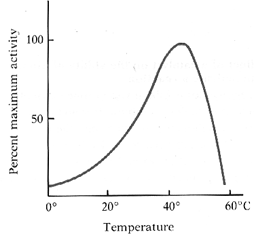How Temperature Affects Reation Rate
of Enzyme Reactions

The graph shows that as temperature is increased, the reaction
rate of an enzyme increases. However, the graph shows that their is an optimum
temperature where the reaction proceeds at its maximum. Above that optimal temperature,
the reaction rate decreases.
What happens can be explained in terms of kinetics, which essentially
means molecular motion. All molecules are in motion (except at absolute zero).
As the temperature increases, their motion increases too. In the case of enzyme
catalyzed reactions, as the speed of enzyme and substrate molecules increases,
the chance for collisions so they can form enzyme-substrate complexes increases.
Thus as the temperature rises, the reaction rate increases too. Above the optimal
temperature however, this does not apply. The reaction rate begins to decrease
again because some of the enzyme molecules are now warm enough so that their
shape becomes altered (H bonds begin to break, denaturing the enzymes). As the
temperature rises above the optimal then, an increasing number of enzymes become
denatured. Fewer and fewer enzymes are able to fit with their substrates at
the active site. The reaction rate decreases until at some high temperature,
all the enzymes are denatured, and reactions cease.
Links for Further Research
Slichter

